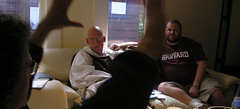Pilgrim revisited
 Big questions about landscape and history are what we do here best.
Big questions about landscape and history are what we do here best. In John Brewer's article, “This, that and the other: Public, social and private in the seventeenth and eighteenth centuries,” chapter one in Shifting the Boundaries: Transformation of the languages of public and private in the Eighteenth Century, eds. (Dario Castiglione and Lesley Sharpe. Exeter: University of Exeter Press, 1995), he sets out to revisit Habermas and Koselleck, German postwar social critics who studied the British eighteenth century.
Habermas and Koselleck study the emerging distinction between public and private in the late seventeenth and eighteenth centuries. Looking at the Enlightenment, both see a lost opportunity for a dialogic politics between the state and the private subject.
Asking, Why did modernity have the fixation with both public and private? Brewer concludes: Because, as Habermas saw, “The public sphere had not only placed unprecedented importance on the private but had provided both the grounds and the means by which it could be colonized and invaded.” In short, eighteenth-century Britons claimed to be independent individuals. But whatever they did -- writing letters, talking in little polite coffee house literary societies -- their speech was in fact controlled by the unspoken, constantly watchful rebukes of others.
Brewer thinks the same watchful guardedness is true of the eighteenth-century city as well:
Domestic space is usually presumed to exemplify the sealed off privateness of the modern, bourgeois household. But, if we look at the representations of seventeenth- and eighteenth-century households examined by Simon Schama, if we look at the language used to describe London burgher households built after the Fire of London and examine their configuration, what we discover are domestic spaces configured to look both out and in. (16)
We may acknowledge that eighteenth-century Britons knew that their houses were subject to regulation, and increasingly they deferred to the assertion of vestry surveyors’ rights to delineate their property.
But householders still protested searches. Even if houses looked out, even if houses had to allow for an intermediary zone that was privately owned but publicly regulated, there was still a very real legal sense of a possible zone exempt from outside authority. Notes Maria Luisa Pesante in Chapter 10, “An Impartial Actor, the Private and the Public Sphere in Adam Smith’s Theory of Moral Sentiments,” “Civic humanist writers maintained that, in modern societies, citizens’ private concerns (that is, their rights to and over both things and persons mediated by things) might be effectively by and from governments” (173).
Given the vulnerability of letters to public scrutiny, where was the private identity located? Put another way, where would contemporaries say lay the literary equivalent of the house’s safebox? Brewer wants us to think that there was none – that any description of the individual self was hypocritical, a Kantian construct overlaid on a society that actually infiltrated all aspects of the human self. But perhaps Brewer gets out of it too easily. As another writer in the same volume concludes, contrary to Brewer, “By talking to the reader, by establishing a relationship, a dialogue can emerge. But it is a dialogue where identities remain secret and where interpretation is of paramount importance.” (Malcolm Cook, “Addressing the Public in Eighteenth-Century French Fiction,” Chapter 3). If all aspects of identity were equally vulnerable to outside perusal, certainly contemporaries elided and secreted certain parts of their every-day lives with astonishing deliberation and regularity.
We see from Brewer’s reading of Habermas that it was indeed difficult for the individual could in fact conceive of himself in terms of Kantian subjectivity in the face of this swarming republic of letters. Brewer leaves the option that an individual could allude to his personal and private life by reference to the family and to other secret organizations – playing one off of the next. But that in fact, a regular part of the discourse was a bluff – an allusion to a secret soul that really had no existence.
I want to play with this notion a little. Brewer is trying to convince us that private communities were universally ones whose members were known – families, corresponding societies, boards of editors. They were therefore equally vulnerable to the critique of each other and of some kind of authority, even if their social networks exempted them from the criticism of the state.
But a secret community is one whose members are hidden from view, and sometimes hidden from each other. Such are the self-understandings of the elite Rosicrucian and Freemason communities handled by Koselleck, whose identity was veiled on earth and known in future or past time or in heaven. Freemasons were, at least, differently from coffee-house poets and corn exchange traders, a social sphere that couldn’t be geographically fixed. Traveling aristocrats – international elites of Freemasons – dispersed, Egyptian magic – the gypsy or the Christian pilgrim on the road – could be seen to share a common identity, without being seen to participate in a common language. Any member of the groups could, from the outside, be understood to carry a private language coming from a collective difference, but not from a collective conversation.
Insofar as they could refer to a body of knowledge that had no circulation – not even social circulation between its members – they could claim to possess an excessive Kantian self-direction in excess of other communities. If not even other Freemasons knew of one’s participation in the order, they had no opportunity to correct one’s thinking.
By positing this theoretical ability to self-direct and critique in compliance with a discourse not located in an earthly social sphere, Freemasons bolstered their confidence in the security of their own identity and reasoning, in the same way that the safe-box did for the householder. This was security, and it contrasts with the raging insecurity Brewer notes felt by individuals sending letters who simultaneously knew that their letters would find public lives, that their private selves were vulnerable to invasion.
This is what the language of Freemasonry, as inserted into sacred solitary retreat, did for the aristocrat. And this is exactly what the language of Christian pilgrimage did for the Quaker and the cobbler. In his The Re-Creation of Landscape (London: University Press of New England, 1984), a study of contemporary landscape poetry and painting, James A. W. Heffernan locates Byron’s Childe Harold’s Pilgrimage as the poet’s own journey (a physical overextension of the Grand Tour through wilder parts of Switzerland) as an attempt to forget his own, and Europe’s, history. Physical travel was a way of escaping social place and contemporary society: it set up a long revolution of the community of God against the City of Man; and it depended exquisitely upon the choices of individuals.
Heffernan goes on to argue that Wordsworth, Constable, and Turner invented a reading of landscape that divorced it from history painting and historical narrative: “Wordsworth locates the shepherd on a distant height with his solitary form etched against the sky: an icon not merely pictorial but religious, the sublime effigy of Christ crucified. Yet this is no ‘pregnant moment’ in a line of historical events. …The result is temporalized space: a description that evokes the fixity of an icon even as it reveals the growth of the poet’s mind, the superimposition of mature experience upon a childhood impression” (93) Landscape seemed for these writers to evade human narrative; to insist on the psychological and religious logic of symbols instead.
Nineteenth-century Britons saw themselves as having independent, self-directed souls, just as much as did Augustine in the fifth century; they had also, as literary critics understand, a heightened awareness of the double-edge by which their letters, diaries and other tools for self-understanding simultaneously compromised that independence. Travel was not a perfect cure for the social soul: but by 1800, circulation was looked on as the best possible cure for local social constraints. In this context, we should read the literary invention of the crowd, and poets’ and novelists’ eerie disjunction with the mass of unreadable faces they encounter in the city (see John Plotz’s study, The Crowd, 1995). The language of civil society was creating an individual who longed to be free of the emotions and opinions of the people around him, and who deliberately created such an alienating experience for himself as he moved about city and country.
The upshot of these premeditated alienations is this: even if nineteenth-century personal identity is a sham, in a postmodern sense of not really being private or independent at all, it was a sham that was intently linked to particular geographies – the geographies of travel. Furthermore, this set of places is, importantly, different from Habermas’s set of town-places that gave rise to the discourse of alienation in the first places.
Travel-place required the participant to perform according to the rituals of independent, Kantian, self-hood – making choices, asking directions, questioning strangers. This individuality was all the more powerful than other contemporary performances of selfhood, because the landscape traveler was constructed, through his psychological readings of the super-historical symbolic landscape, as carrying all the authority of a member of a transient, invisible, secret community. Nor would this community ever critique or question the individual as would a community of letters or the bourgeois family; for this individual was a member of the city of travelers who would only be reassembled in Zion.
Technorati Tags: crowds, britain, victorian, politics, georgian, space, freemasonry, privacy, pilgrimage, landscape, mapping, habermas, community, secrecy,stratego










0 Comments:
Post a Comment
<< Home